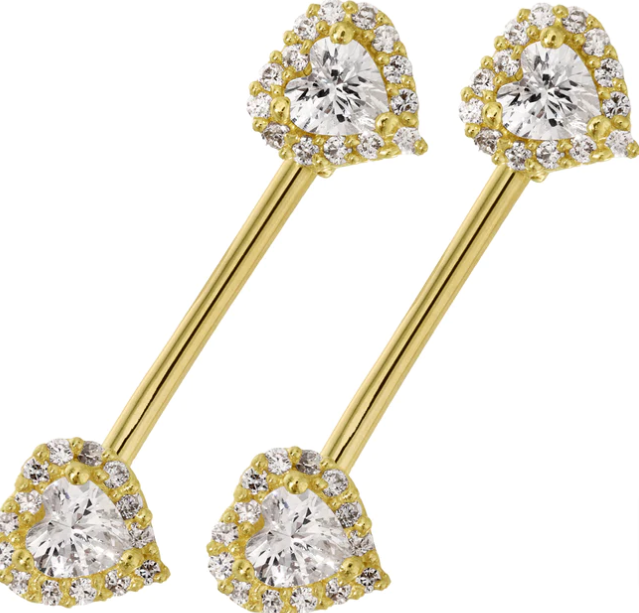While some individuals assert that nipple piercings enhance sexual gratification for both themselves and their partners, it's crucial to note that improper care of nipple piercings can lead to piercing infections.
Ancient Romans
The nipple is not the only place on the human body that can be pierced to display jewelry. The clitoral hood, also known as the “nipple hole” is another site where people choose to adorn themselves. It is located in the nipples’ inner fold, and it is an ideal location for a piece of jewelry because it allows the wearer to add a little bit of flair and style to a normally dull area.Whether or not nipple piercings jewelry were prevalent in ancient Roman times remains unclear, but they did emerge as a trendy fashion statement in the 14th century. Queen Isabella of France was an avid fan of plunging necklines, introducing gowns that featured low-cut designs reaching down to expose the nipples. This style gave way for wealthy women to proudly display their pierced nipples adorned with lavish jewels.
Nipple piercings have had a longstanding presence in various cultures across history, including ancient Polynesia where the Guiche piercing was practiced. Traditionally performed by a Mahu or healer, this piercing was believed to help sailors determine wave direction as they would hang a weight from it.
The first recorded use of nipple piercings was by females in medieval Europe, according to Kern. These piercings were used to decorate the nipples and were a source of pleasure. In this time, nipple piercings became a symbol of femininity and beauty.
In modern times, nipple piercings are seen as a fashion accessory and a form of art. They can be worn alone or paired with other jewelry to create a unique look. Many women choose to get their nipples pierced for a sense of freedom and empowerment. In addition to this, nipple piercings have become popular in the queer and kink communities because they can be a way to express sex and sexuality.
While it is true that nipple piercings can be controversial, the fact is that they are no less valid than other forms of self-expression. By understanding the current significance of nipple piercings, it is possible to gain a better perspective on these issues and to make informed choices about the piercings you want to have.
Ancient Greeks
When we think of ancient Greece, we think of white togas and laced sandals. You might imagine the first Olympics and all-powerful gods associated with Greek culture. You may not associate nipple piercing jewelry with this culture, but it was actually very common. Ancient Greeks wore many types of jewelry, including nipple studs. These studs were made of gold, silver, glass, pearls, and other precious stones. They also used them to depict mythological scenes or to celebrate Greek victories.The ancient Greeks were heavily influenced by neighboring empires, but they incorporated their own elements into their jewelry. They often used precious stones such as topaz, agate, carnelian, cornelian, emerald, and aquamarine. They also preferred gold as a base material for their jewelry.
These pieces of jewelry were usually decorated with images of the goddess Aphrodite, who symbolized love and beauty. Women hoped to attract men and find true love by wearing the likeness of Aphrodite. They would also display these adornments as a sign of their status in society and wealth.
Another popular piece of nipple jewelry was the labret. The ancient Aztecs and the Maya wore labrets that were fashioned of pure gold to look like serpents or of jade, obsidian, or bone. Native Americans of the Pacific Northwest and Alaska wore labrets of walrus ivory, abalone shell, or wood.
Nipple piercings have been around for thousands of years and continue to be a symbol of femininity, strength and beauty. Although they are frowned upon by some acupuncturists due to their potential to disrupt the flow of energy, they remain an important part of many cultures.
While some consider While nipple piercing is a sign of masculinity or sexuality, others see it as a form of self-expression. Whatever their meaning, nipple piercings are a great way to express your personality. In today's world, nipple piercings have become more of a fashion statement than a cultural norm, but they can still be a great way to express your personality and style. Whatever meaning you place on nipple piercing, make sure it's the right choice for you and makes you happy.
Early Native American tribes
In tribal societies, body piercings were not only a form of self-expression but also had deep religious and spiritual significance. They were used to signify fertility rituals, communicate with the gods, and mark rites of passage. They also served as a way to show social status and rank in the tribe. Moreover, they were often adorned with sacred symbols and amulets to provide protection or invoke blessings from the divine.Roman centurions used to have their nipples punctured in order to wear breast plates made of fitting leather armor that featured rings where the nipples should have been. In the 20th century, this practice finally caused nipple piercing to become connected to the LGBT and BDSM groups. To prevent infection, it's crucial to remember that nipple piercings should only be done by qualified specialists once the body has fully healed.
Both the Algerian Kabyle tribe and the Karankawa Native Americans had their nipples pierced in the 1800s. Today, women are more likely to have nipple piercings, and because they can give more stimulation during sexual activity, they have recently become more fashionable. It’s also been seen on celebrities like Lenny Kravitz, Gerry Connelly and musicians like Tommy Lee (Motley Crue) and Axl Rose (Guns & Roses).
Tribal tribes believed that by piercing the body, they opened up a channel for communication between the physical and spiritual worlds. This is why some tribes also wore nose, lip and ear piercings to amplify their sense of smell, enhance their hearing and see the invisible.
Ear piercing was also a common practice in tribal societies, particularly for young girls as part of their initiation into adulthood. In fact, a pierced ear was sometimes even used as a currency by sailors who had it pierced in the belief that it would prevent demons and spirits from entering their bodies at sea. It was also a symbol of status among the tribes and a way to distinguish a man from his wife. They were pierced with rings made of ivory, bone or obsidian, depending on their level of social standing.
Modern day
Nipple piercings, especially the 14k gold nipple piercing jewelry are not just a fleeting trend; they are a profound declaration of self-expression. These tiny metallic accents not only celebrate personal sexuality, which is often misunderstood or judged, but also act as an empowering tool to amplify confidence and self-appreciation. The allure of heightened sensitivity and increased libido perhaps adds to their popularity especially among women. Yet, one must tread carefully, recognizing the importance of choosing a reputable professional to mitigate any health risks associated with this bold choice.As we navigate the ever-evolving acceptance of body art, nipple piercings have emerged as a cherished emblem of uniqueness. Flaunting one’s distinctive taste through this modification comes with an array of elegant and edgy jewelry options. Those new to the realm of nipple adornments might find solace in segment rings, renowned for their comfort and safety, ensuring an inviting introduction into this exhilarating form of self-expression without compromising on style or wellbeing.
Although nipple piercings were once an unpopular form of adornment, they became popular again in the 1960s. During this time, they were associated with a punk rock attitude and non-conformity. They also reflected the feminist movement that was taking place at the time. Nipple piercings are still popular today and can be found on the bodies of many people, including famous celebrities.
Nipple piercing stands out as an exceptionally adaptable body modification, offering a variety of angles for placement. While the horizontal position is the most common, vertical and diagonal orientations are also viable options. The angle at which you choose to pierce your nipple can convey distinct meanings. For instance, a diagonal piercing may exude an energetic vibe, whereas a horizontal one often projects a more delicate aesthetic.
The nipple piercing first appeared in the 14th century, and it was popularized by Isabella of Bavaria, who wore nipple studs with diamonds that were passed through gold chains. However, the medical community didn’t like it, and they argued that the nipple piercing was bad for your health and encouraged ‘unhealthy sensuality.’ This is probably what led to the downfall of bosom rings in America, as they were replaced by hoop earrings.

